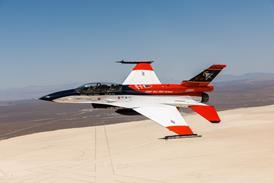The US Navy has ordered a three-day grounding of its T-45 Goshawk trainer jets while US Naval Air Systems Command (NAVAIR) looks for ways to correct persistent oxygen issues on the aircraft.
The Navy canceled about 40% of its T-45 flights 31 March at its training commands in Mississippi, Florida and Texas after pilots expressed concern over recent physiological episodes experienced in the cockpit caused by contamination of the aircraft's oxygen system, a Navy spokesman stated in an email to FlightGlobal this week. The Chief of Naval Air Training is working to correct the problem with engineering experts at NAVAIR and conducted briefs with the pilots in all three training wings this week, the spokesman says. The Navy is using “unconstrained resources” to tackle the issue and potential solutions have neither manpower nor cost restraints, she adds.
“This is a complex problem with multiple interrelated potential causal factors,” she says. “The root cause of physiological episodes remains unidentified, but engineers are working diligently to find a solution.”
The order comes after a 4 April media report revealing that more than 100 US Navy instructor pilots are boycotting the T-45 flights until high-level Navy officials address the jets’ oxygen system issues. Earlier this year, naval air forces commander Vice Adm Mike Shoemaker called the physiological events on the T-45, EA-18Gs and F/A-18F/Gs his “number one safety priority across the force,” pointing to continual breathing problems related to the onboard oxygen generation systems (OBOGS) and contaminated gas.
“Aggressive efforts to upgrade components and the materials used to detect ‘bad air’ are in work, however, we do know that component failures as well as flow, pressure, concentration problems are generally accompanied by warnings from the aircraft, and manual activation of emergency oxygen is very effective,” he stated in January. “Our challenge is contaminated air, for which we currently have no warning system.”
Hypoxia has plagued the Navy’s T-45s and larger fleet of F/A-18 fleet for years now, but the issue has recently received more attention on Capitol Hill. During a 28 March House Armed Services Committee hearing, members of Congress expressed concern over dangerous crew cabin pressure in the older Super Hornets and possible oxygen contamination in the newer F/A-18 variants. The F/A-18A through D models saw a 90% increase in physiological episodes (PEs) over the last fiscal year, while the E and F models saw an 11% increase in the same period. Meanwhile, the EA-18G doubled its number of PEs during that same time.
Source: FlightGlobal.com
















